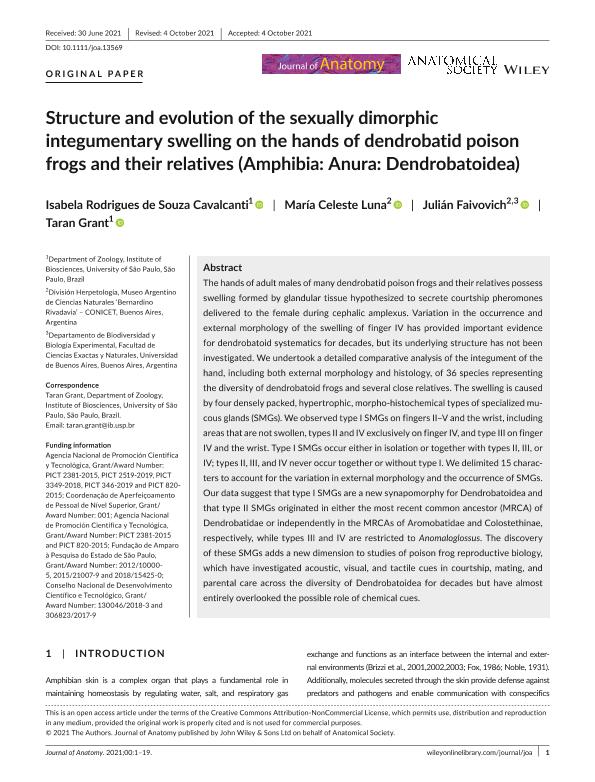Artículo
Structure and evolution of the sexually dimorphic integumentary swelling on the hands of dendrobatid poison frogs and their relatives (Amphibia: Anura: Dendrobatoidea)
Fecha de publicación:
11/2021
Editorial:
Wiley Blackwell Publishing, Inc
Revista:
Journal of Anatomy
ISSN:
0021-8782
Idioma:
Inglés
Tipo de recurso:
Artículo publicado
Clasificación temática:
Resumen
The hands of adult males of many dendrobatid poison frogs and their relatives possess swelling formed by glandular tissue hypothesized to secrete courtship pheromones delivered to the female during cephalic amplexus. Variation in the occurrence and external morphology of the swelling of finger IV has provided important evidence for dendrobatoid systematics for decades, but its underlying structure has not been investigated. We undertook a detailed comparative analysis of the integument of the hand, including both external morphology and histology, of 36 species representing the diversity of dendrobatoid frogs and several close relatives. The swelling is caused by four densely packed, hypertrophic, morpho-histochemical types of specialized mucous glands (SMGs). We observed type I SMGs on fingers II–V and the wrist, including areas that are not swollen, types II and IV exclusively on finger IV, and type III on finger IV and the wrist. Type I SMGs occur either in isolation or together with types II, III, or IV; types II, III, and IV never occur together or without type I. We delimited 15 characters to account for the variation in external morphology and the occurrence of SMGs. Our data suggest that type I SMGs are a new synapomorphy for Dendrobatoidea and that type II SMGs originated in either the most recent common ancestor (MRCA) of Dendrobatidae or independently in the MRCAs of Aromobatidae and Colostethinae, respectively, while types III and IV are restricted to Anomaloglossus. The discovery of these SMGs adds a new dimension to studies of poison frog reproductive biology, which have investigated acoustic, visual, and tactile cues in courtship, mating, and parental care across the diversity of Dendrobatoidea for decades but have almost entirely overlooked the possible role of chemical cues.
Palabras clave:
Anuda
,
Dendrobatoidea
Archivos asociados
Licencia
Identificadores
Colecciones
Articulos(MACNBR)
Articulos de MUSEO ARG.DE CS.NAT "BERNARDINO RIVADAVIA"
Articulos de MUSEO ARG.DE CS.NAT "BERNARDINO RIVADAVIA"
Citación
Rodrigues de Souza Cavalcant, Isabela; Luna, María Celeste; Faivovich, Julián; Grant, Taran; Structure and evolution of the sexually dimorphic integumentary swelling on the hands of dendrobatid poison frogs and their relatives (Amphibia: Anura: Dendrobatoidea); Wiley Blackwell Publishing, Inc; Journal of Anatomy; 240; 3; 11-2021; 447-465
Compartir
Altmétricas




